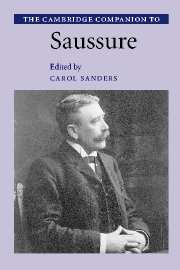Book contents
- Frontmatter
- Introduction: Saussure today
- Part I Out of the nineteenth century
- Part II The ‘Course in General Linguistics’
- 3 The making of the Cours de linguistique générale
- 4 The linguistic sign
- 5 Langue and parole
- 6 System, arbitrariness, value
- Part III After the Cours
- Part IV New debates and directions
- Notes
- Works by Saussure and further reading
- References
- Index
3 - The making of the Cours de linguistique générale
from Part II - The ‘Course in General Linguistics’
Published online by Cambridge University Press: 28 May 2006
- Frontmatter
- Introduction: Saussure today
- Part I Out of the nineteenth century
- Part II The ‘Course in General Linguistics’
- 3 The making of the Cours de linguistique générale
- 4 The linguistic sign
- 5 Langue and parole
- 6 System, arbitrariness, value
- Part III After the Cours
- Part IV New debates and directions
- Notes
- Works by Saussure and further reading
- References
- Index
Summary
On the history of the Cours, the task which faced its 'author-editors' Bally and Sechehaye in 1913, and how they acquitted themselves, the reader can consult Godel (1957), Engler (1959, 1968b, 1987b), Vallini (1979) and Linda (2001).
Let us make a few points clear. The Cours (or CLG) does not contain Saussure's 'actual words' but a subsequent digest of three courses (based on lecture notes kept by a few conscientious students) and of certain handwritten observations which testify to a longstanding reflection on the 'essence' of linguistics. Saussure had always said that he would never publish any of these reflections. Without the bold and assiduous determination of Bally and Sechehaye, Saussure's thought would probably have never reached the reading public, any more than did that of his contemporary Marty. Without the CLG, the interest shown today in the discovery of any new Saussurean document would not exist
Hence the existence of the CLG is in itself a fact of historical significance. The publication of the first ‘authentic’ texts associated with the linguist (Godel, 1957; Saussure, 1968 and 1974 (CLG/E, vols. 1 and 2)), is the second event of importance and it has allowed for a two-way evaluation. It led to new interpretations, valuable but provisional, as has been shown by the 1996 appearance of a Saussurean manuscript dating from 1891, and containing in essence the whole of Saussure’s ‘general and semiological linguistics’, as well as totally unexpected thoughts on ‘semantics’ (Saussure, 2002 (ELG)).
- Type
- Chapter
- Information
- The Cambridge Companion to Saussure , pp. 47 - 58Publisher: Cambridge University PressPrint publication year: 2004
- 9
- Cited by



